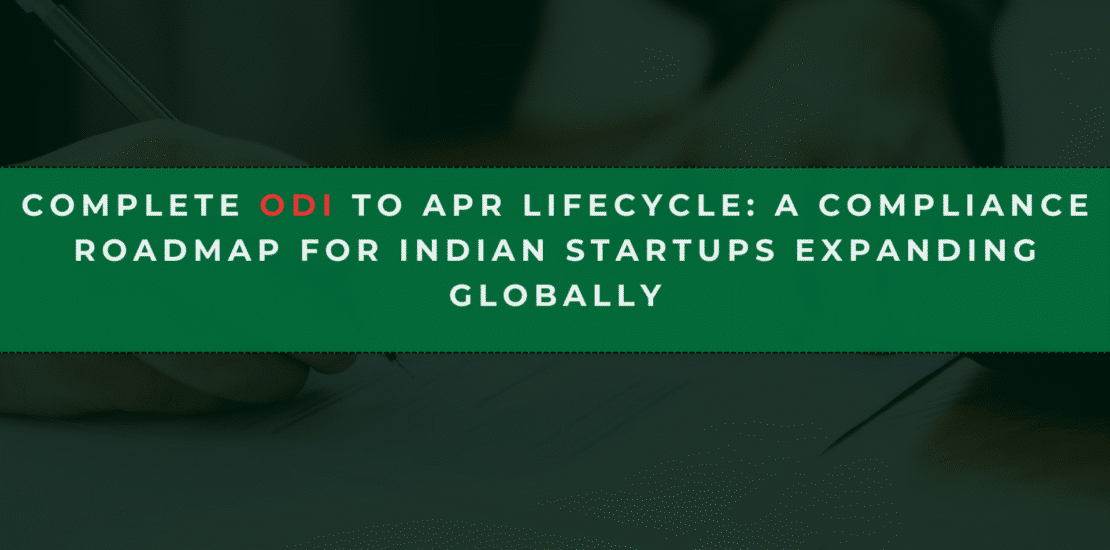Complete ODI to APR Lifecycle: A Compliance Roadmap for Indian Startups Expanding Globally
- July 7, 2025
- Posted by: Noushed Shaikh
- Category: Uncategorized

Why Understanding the ODI to APR Process Matters
Understanding the ODI to APR lifecycle is essential if you are an Indian entrepreneur ready to grow your company abroad. From making investments in a foreign company to reporting its performance, every step requires compliance with the Reserve Bank of India (RBI).
This guide outlines the entire process. This roadmap will help you stay compliant and on track, whether you are setting up a joint venture in Europe or a subsidiary in the United States.
What Is the ODI Lifecycle?
The ODI lifecycle refers to the entire process Indian companies follow when investing overseas. It begins with the investment decision and continues through approvals, documentation, annual reporting, and closure if necessary.
The RBI closely monitors each stage to ensure that Indian companies follow foreign exchange policies, maintain transparency, and report accurate data.
Key Stages in the ODI to APR Lifecycle

1. Plan Your Overseas Investment
Before making an overseas investment, assess whether your company is ready for global expansion. This includes understanding the legal framework of the destination country and deciding whether to establish a joint venture or a wholly owned subsidiary.
Many entrepreneurs also consult with legal or compliance experts to ensure that their plans align with RBI’s ODI regulations.
2. Make the First Payment
Once your investment is approved, your company will remit funds through an Authorised Dealer (AD) bank. Under the ODI process, this remittance must be reported and is not treated as a regular transfer.
You will also need to submit Form FC along with supporting documents such as board resolutions, shareholding structures, and valuation reports.
3. Obtain Share Certificates Within 6 Months
You must obtain share certificates from the foreign entity within six months of the fund transfer. These certificates serve as proof of ownership in the overseas business.
Failure to obtain or submit these documents on time can lead to compliance issues.
4. File Event-Based Updates (If Any)
If your foreign subsidiary undergoes structural changes such as capital infusion, share transfers, or closure, you must report these changes using Form FC.
This ensures transparency and allows the RBI to stay updated on changes in your foreign investment.
5. Submit the Annual Performance Report (APR)
Indian companies with overseas investments are required to file an Annual Performance Report (APR) to the RBI. This report captures key financial information about the foreign entity, including:
- Total income and profit or loss
- Shareholding structure
- Assets and liabilities
- Operational status
The APR for each financial year must be submitted by December 31 through Authorised dealer bank.
Why APR Filing Is an Important Part of the Lifecycle
APR filing is the final and ongoing step in the ODI lifecycle. It acts as a performance update to the RBI, confirming that the foreign entity is operating correctly and that Indian investments are secure and productive.
Failing to file APRs, even for dormant or inactive foreign subsidiaries, can result in:
- Penalties under FEMA
- Delays in receiving approvals for future overseas investments
- Damage to your reputation with banks and international partners
Common Mistakes to Avoid
Not Collecting Share Certificates on Time
Startups often overlook the deadline for obtaining share certificates. Always ensure that official proof of ownership is available within six months.
Missing Event-Based Filings
Any change in the structure, shareholding, or operational status of the foreign entity must be reported. Failure to do so can lead to compliance gaps.
Practical Tips for Smooth ODI to APR Compliance
Keep All Compliance Records in One Place
Store all important documents such as ODI approvals, remittance proofs, share certificates, and past APRs in a central, secure location.
Mark Your Calendar for Key Dates
Highlight important deadlines like share certificate submission and APR filing on your compliance calendar to avoid last-minute stress.
Stay Updated with RBI Guidelines
Monitor official RBI circulars and notifications. These may introduce changes in deadlines, formats, or reporting rules.
Work with a Compliance Expert
Hiring a compliance advisor helps reduce the chances of errors and ensures that all stages of the ODI lifecycle are managed efficiently.
Using Authorised Dealer bank for ODI and APR
All APRs must be submitted through the Authorized Dealer (AD) Bank. You’ll need to submit APR along with audited financial statement.
The AD bank will review your submission before forwarding it to the RBI.
What Happens If You Don’t Comply?
Non-compliance at any stage of the ODI lifecycle can result in:
- Penalties under the Foreign Exchange Management Act (FEMA)
- Delays or rejection of future ODI approvals
- Closer scrutiny from your AD bank and the RBI
Even a single missed filing can disrupt your global expansion plans
Need help with your ODI or APR filing? [Schedule a free consultation today]
At LedgersCFO, we understand that managing overseas investments from ODI filings to APR submissions can be a challenge for growing startups. Whether you’re setting up your first foreign subsidiary or struggling to keep up with RBI’s compliance requirements, it’s easy to feel unsure about the next steps.
That’s where we come in. Our team will guide you through each stage of the ODI to APR lifecycle from initial investment documentation to annual performance reporting, ensuring everything is filed accurately and on time.
While you focus on expanding your business globally, we’ll take care of the compliance side with precision and professionalism.
FAQ’S
1. Who is required to follow the ODI to the APR lifecycle?
Any Indian startup or business that has made an Overseas Direct Investment (ODI), whether by setting up a foreign subsidiary, entering into a joint venture, or acquiring shares in a foreign company, must follow the complete ODI to APR compliance process as per RBI guidelines.
2. What documents are needed to begin the ODI process?
To initiate an ODI, you will need board resolutions, valuation reports, shareholding structure details, and Form ODI – Part I. These documents must be submitted through your Authorised Dealer (AD) bank before the remittance is made.
3. Is the APR filing mandatory if the foreign unit is inactive?
Yes, even if your foreign subsidiary or joint venture is dormant or not operational during the financial year, APR filing is still mandatory. RBI requires an update every year to monitor all foreign investments, active or inactive
4.How does LedgersCFO help with ODI and APR compliance?
At LedgersCFO, we support you through every stage of the ODI to APR lifecycle. From preparing Form ODI and coordinating with your Authorised Dealer bank to submitting Annual Performance Reports, our experts make sure your filings are timely, accurate, and fully compliant with RBI requirements. Whether it’s your first foreign investment or an ongoing overseas operation, we’re here to help you stay on track.


